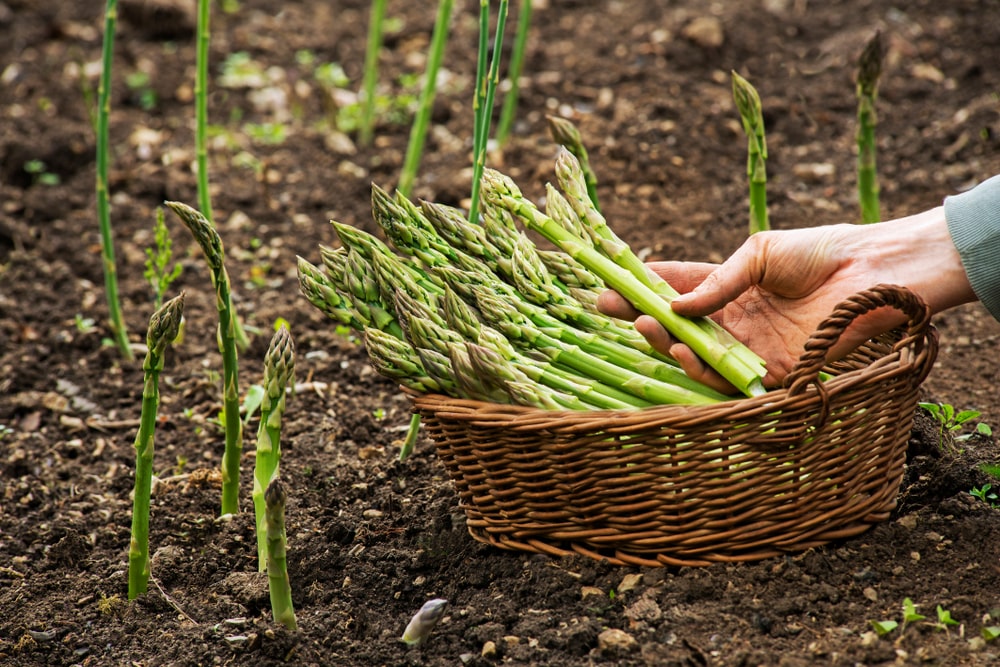What is tastier than asparagus straight from the garden—or strawberries still warm from the sun; spring onions so fresh that soil is still clinging to them? There are many edibles that are grown from packaged roots. They are easy, inexpensive, and fun to grow. Some are even perennial and will provide delicious vegetables for many years.
Some Delicious Edibles You Can Plant and Enjoy
ASPARAGUS
Perennial—Plant roots in full to part-sun in soil amended with compost or composted manures. Asparagus prefers soil with a pH of 6.5 to 7.5, so have the soil tested and amend it if necessary. Loosen the soil to a depth of 12 inches, and plant crowns two inches below the soil surface, spaced two feet apart.
Asparagus hates competition, so mulch well and keep weeded. Do not harvest spears the first year. Allow foliage to grow undisturbed. In the second year, harvest no more than two or three spears per plant. Thereafter, you may harvest until new spears are no bigger around than a pencil—usually four to six weeks.
HORSERADISH
Perennial—Loosen the soil to a depth of 10 to 12 inches and set roots two inches deep and at least 18 inches apart. Plant roots at an angle, thin end down. Horseradish, once established, can be a rampant spreader to keep this in mind when choosing a location. Horseradish prefers full to part-sun.
ONIONS, GARLIC, SHALLOTS
Plant sets six inches apart, two inches deep in full sun. For garlic, separate the head into individual cloves before planting. All prefer well-draining soil. Mulch with a loose fluffy mulch (pine needles, straw, dried leaves) over winter. Harvest when tops die back. If planting onions for scallions harvest when the top is the desired size. Onions prefer a pH of 5.5 to 6.5.
POTATOES
Plant seed potatoes in full sun in a six-inch deep trough, 12 inches apart, and cover with four inches of soil. When foliage is six inches tall, make “hills” around the base of each plant to just beneath the bottom leaves. Continue to “hill” as plants grow until they begin to bloom. When plants start to bloom, new potatoes can be harvested by gently feeling in the soil around the stems.
Mature potatoes can be harvested when the tops die back. If the soil is not too damp, they can be left in the ground for an additional week or two for the skins to “set”. Potatoes should be watered with about one inch of water once a week. Use a good fertilizer regularly (I use Tomato-tone) until mid-summer, then stop feeding. Feeding later in the season will induce top growth at the expense of the potatoes.
Discard any green potatoes. Because potatoes are related to tomatoes and prone to the same diseases, do not plant potatoes where you’ve had a problem with a tomato disease.
RHUBARB
Perennial—Loosen soil 10 to 12 inches deep and plant crowns two inches below the soil surface, spacing two feet apart. Slightly acidic soil close to a pH of 6.5 is best. Like asparagus, rhubarb hates competition, so mulch well and keep it weeded. Do not harvest the first season—allow it to grow undisturbed. Only the stems are edible—do not eat the roots or leaves.
STRAWBERRIES
Plant as soon as available in full sun, with the crown at the soil surface. Strawberries prefer well-drained soil to which compost has been added. A pH of 6 to 6.5 is best. June-bearing plants will produce a larger crop over a shorter period of time, so is best if you are making jams or jellies. Everbearing plants produce over a long period of time, so they are better for fresh eating. In the first year, pinch off flowers on everbearing strawberries until July. Pinch off both flowers and runners on June-bearing the first year for a bigger crop the next.
SWEET POTATOES
Place sweet potato, root side down, in a glass half-full of water. When shoots form and are about six inches long, remove them from the tuber and place them in their own glass of water. Once roots form, the shoots can be planted. Sweet potatoes are warm weather lovers, so don’t plant directly in the ground until the first week in May. Plant in sun. They form long, lush vines, so keep that in mind when planting. When leaves begin to yellow and die back in the fall (but BEFORE the first frost), sweet potatoes can be dug.
Grow Your Own
Growing your own veggies and fruit is fun and delicious. If you have any questions, give us a call! Better yet, stop by to get everything you need, along with expert advice tailored to your specific yard conditions.

